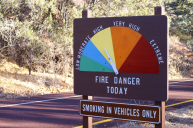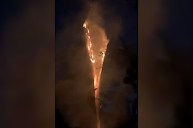The U.S. Forest Service issued what it called the final incident update for the Royal Fire in Tahoe National Forest. According to Tuesday's announcement, crews contained 95% of the fire, but the forest will remain closed due to safety concerns.
In the statement, the Forest Service said that officials received reports of the Royal Fire on July 7 at around 4:09 p.m. However, due to the steep and rugged terrain, firefighters responded immediately with aggressive aerial resources as ground crews made their way over.
Although officials listed the cause of the fire as unknown, they also reported that the area received 158 lightning strikes over the weekend, which resulted in four fires. However, firefighters were able to immediately suppress the new fires.

Fire crews containing wildfires in Tahoe National Forest. Credit: USFS/Facebook
According to press materials, Tahoe National Forest received aid and support from not just the federal government but also local and state agencies across the country. "Just nine days after igniting in some of America's most steep and rugged country, the Royal Fire on Tahoe National Forest is 95% contained," the agency said, adding that firefighters as far as Montana, South Dakota, Minnesota, Virginia, and Florida assisted.
The Fire Service added that while fire crews have contained the fire, the area will remain closed. Officials advised the public to avoid recently burned areas as weekend trees could easily be downed by wind and result in injury. Additionally, ash pits and burned stump holes have the potential to cause severe burns and injuries.
Lightning-caused wildfires and safety

Don't go into recently burned areas, and avoid ash pits and burned stump holes in areas like Tahoe National Forest, which experienced wildfires. Credit: USFS/Facebook
Lighting-caused wildfires typically occur when there's rapid growth in the spring followed by hot summer months with low humidity. All the dry vegetation creates the perfect fuel for wildfire. Under those conditions, a single spark could start a fire.
According to data collected by the National Interagency Fire Center, the United States experiences thousands of wildfires caused by lightning strikes each year. Last year, the country saw a total of 5,883, down by about 1,500 from the year before. What's more, Cal Fire reported that California saw 9,117 lightning bolts between July 14 and 16, which caused 51 fires across the state.
Additionally, certain areas of the country. The data shows that most of the lightning-caused wildfires occur in western states. The National Park Service explains on its website that the most dangerous places to be during a lightning storm are the tops of mountains, under trees, and in the water.




